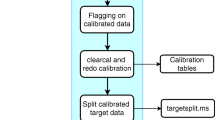Abstract
AstroDART is a Python package that implements a pipeline for processing, analyzing, and managing files derived from observations performed by ground-based optical telescopes. The main goal is to develop a software capable of retrieving information about satellites’ tracklets. In between its functionalities the following are included: perform astrometric reduction using Astrometry.net, detect tracklets using contour tracing techniques with ASTRiDE Python Package, refine the detected tracklets and perform telescope calibration by comparing the observations of known objects with catalogue data and obtaining the celestial coordinates of the object at the observation epoch. In addition, it produces the light curve and TDM files derived from the observations. The computation times are in the order of 15 s per image when no astrometric reduction is performed, increased to 50 s when the astrometric reduction and light curve analysis are included. The average residuals for both right ascension and declination are found to be lower than 9 arcsecs for all of the three test campaigns.










Similar content being viewed by others
Data availability
The data used in the testing campaigns (images of sky surveys) are not currently available for the general public.
References
De Vittori, A., Cipollone, R., Di Lizia, P., Massari, M.: Real-time space object tracklet extraction from telescope survey images with machine learning. Astrodynamics 6(2), 205–218 (2022)
Del Genio, G.M., Paoli, J., Del Grande, E. et al.: Italian Air Force radar and optical sensor experiments for the detection of space objects in LEO orbit. In Proceedings of the Advanced Maui Optical and Space Surveillance Technologies Conference, volume 1, page 3, (2015)
ESA. Space environment statistics. https://sdup.esoc.esa.int/discosweb/statistics/. Accessed 1 May 2023
Gallucci, M.: Light curve inversion for attitude reconstruction of tumbling space debris. Master’s thesis, Politecnico di Milano, (2021)
Kim, D.-W.: ASTRiDE: Automated Streak Detection for Astronomical Images. Astrophysics Source Code Library, record ascl:1605.009, (2016)
Lang, D., Hogg, D.W., Mierle, K., et al.: Astrometry.net: Blind Astrometric Calibration of Arbitrary Astronomical Images. Astronom. J. 139(5), 1782–1800 (2010). https://doi.org/10.1088/0004-6256/139/5/1782
Lavezzi, G.: Image processing of multiclass satellite tracklets for initial orbit determination based on optical telescopes. Master’s thesis, Politecnico di Milano, (2018)
München, T.U.: Eurolas data centre. https://edc.dgfi.tum.de/en/. Accessed 20 July 2023
Mancas, A., Jilete, B., Flohrer, T.: Qualification approach for space debris monitoring optical sensor, vol. 1. European Space Agency, ESA Space Safety Programme Office (2019)
NASA. International Laser Ranging Service. https://ilrs.gsfc.nasa.gov/. Accessed 5 Sept 2023
NASA. The SPICE Toolkit. https://naif.jpl.nasa.gov/naif/toolkit.html. Accessed 5 Sept 2023
Schafer, R.W.: What is a savitzky-golay filter?[lecture notes]. IEEE Signal Process. Mag. 28(4), 111–117 (2011)
Acknowledgements
The author of this paper would like to acknowledge the crucial support of the Italian Air Force with the invaluable material provided. The numerous images from their telescope observation campaign were key for an adequate algorithm testing phase. Additionally, the author wishes to express its deepest gratitude to Pierluigi Di Lizia, Giovanni Purpura, and Luca Facchini (DAER, Politecnico di Milano) for their support and advice during the developement of this project.
Funding
The author of this research received no specific grant from any funding agency in the public, commercial, or not-for-profit sectors.
Author information
Authors and Affiliations
Corresponding author
Ethics declarations
Conflict of interest
The author of this paper states that there is no conflict of interest.
Additional information
Publisher's Note
Springer Nature remains neutral with regard to jurisdictional claims in published maps and institutional affiliations.
Rights and permissions
Springer Nature or its licensor (e.g. a society or other partner) holds exclusive rights to this article under a publishing agreement with the author(s) or other rightsholder(s); author self-archiving of the accepted manuscript version of this article is solely governed by the terms of such publishing agreement and applicable law.
About this article
Cite this article
López-Cepero, J.G. AstroDART: Astronomical Data Analysis and Recovery from Tracklets. Aerotec. Missili Spaz. 102, 355–365 (2023). https://doi.org/10.1007/s42496-023-00174-5
Received:
Revised:
Accepted:
Published:
Issue Date:
DOI: https://doi.org/10.1007/s42496-023-00174-5




